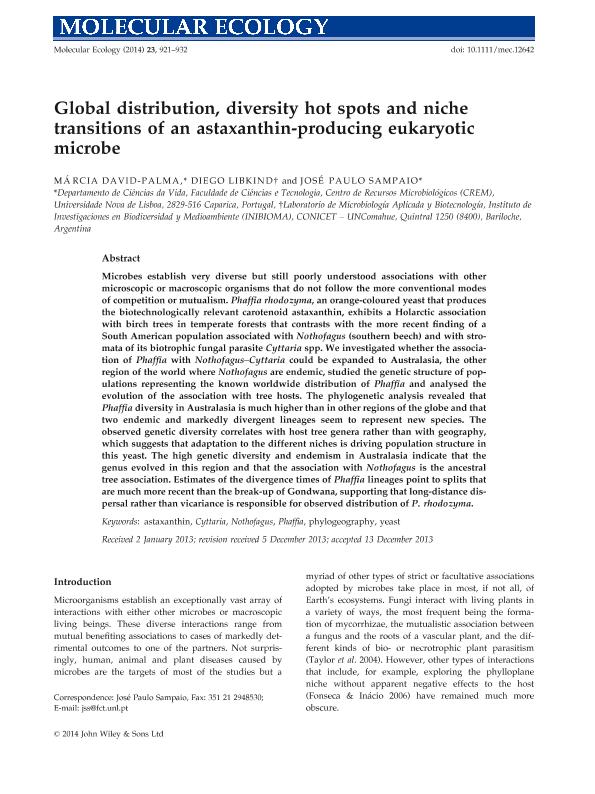Mostrar el registro sencillo del ítem
dc.contributor.author
David Palma, Márcia
dc.contributor.author
Libkind Frati, Diego

dc.contributor.author
Sampaio, José Paulo
dc.date.available
2017-01-24T14:34:57Z
dc.date.issued
2014-02
dc.identifier.citation
David Palma, Márcia; Libkind Frati, Diego; Sampaio, José Paulo; Global distribution, diversity hotspots and niche transitions of an astaxanthin-producing eukaryotic microbe; Wiley; Molecular Ecology; 23; 4; 2-2014; 921-932
dc.identifier.issn
0962-1083
dc.identifier.uri
http://hdl.handle.net/11336/11768
dc.description.abstract
Microbes establish very diverse but still poorly understood associations with other microscopic or macroscopic organisms that do not follow the more conventional modes of competition or mutualism. Phaffia rhodozyma, an orange-coloured yeast that produces the biotechnologically relevant carotenoid astaxanthin and grows in sugar-rich tree exudates, exhibits an Holarctic association with birch trees in temperate forests that contrasts with the more recent finding of a South American population associated with Nothofagus (southern beech) and with stromata of its biotrophic fungal parasite Cyttaria spp. Here we first investigated if the association of Phaffia with Nothofagus-Cyttaria could be expanded to Australasia, the other region of the world where Nothofagus are endemic, and then studied the genetic structure of populations representing the known worldwide distribution of Phaffia and analyzed the evolution of the association with tree hosts. The phylogenetic analysis of concatenated partial sequences of seven genes from forty strains revealed that Phaffia diversity in Australasia is much higher than in other regions of the globe and that two endemic and markedly divergent lineages seem to represent new species. Moreover, the observed genetic diversity correlates with host tree genera rather than with geography, which suggests that adaptation to the different niches is driving population structure in this yeast. The high genetic diversity and endemism in Australasia indicates that the genus Phaffia evolved in this region and that the association with Nothofagus is the ancestral tree-association. Our estimates of the divergence times of the various Phaffia lineages point to splits that are much more recent than the breakup of Gondwana. This suggests that long distance dispersal rather than vicariance is responsible for the presence of P. rhodozyma in Australasia, South America and in the Holarctic region.
dc.format
application/pdf
dc.language.iso
eng
dc.publisher
Wiley

dc.rights
info:eu-repo/semantics/openAccess
dc.rights.uri
https://creativecommons.org/licenses/by-nc-sa/2.5/ar/
dc.subject
Astaxanthin
dc.subject
Cyttaria
dc.subject
Nothofagus
dc.subject
Phaffia
dc.subject
Phylogeography
dc.subject
Yeast
dc.subject.classification
Otras Ciencias Naturales y Exactas

dc.subject.classification
Otras Ciencias Naturales y Exactas

dc.subject.classification
CIENCIAS NATURALES Y EXACTAS

dc.subject.classification
Otras Ciencias Naturales y Exactas

dc.subject.classification
Otras Ciencias Naturales y Exactas

dc.subject.classification
CIENCIAS NATURALES Y EXACTAS

dc.title
Global distribution, diversity hotspots and niche transitions of an astaxanthin-producing eukaryotic microbe
dc.type
info:eu-repo/semantics/article
dc.type
info:ar-repo/semantics/artículo
dc.type
info:eu-repo/semantics/publishedVersion
dc.date.updated
2016-12-12T14:20:59Z
dc.identifier.eissn
1365-294X
dc.journal.volume
23
dc.journal.number
4
dc.journal.pagination
921-932
dc.journal.pais
Estados Unidos

dc.journal.ciudad
Nueva York
dc.description.fil
Fil: David Palma, Márcia. Universidade Nova de Lisboa; Portugal
dc.description.fil
Fil: Libkind Frati, Diego. Consejo Nacional de Investigaciones Científicas y Técnicas. Centro Científico Tecnológico Patagonia Norte. Instituto de Investigación en Biodiversidad y Medioambiente; Argentina. Universidad Nacional del Comahue; Argentina
dc.description.fil
Fil: Sampaio, José Paulo. Universidade Nova de Lisboa; Portugal
dc.journal.title
Molecular Ecology

dc.relation.alternativeid
info:eu-repo/semantics/altIdentifier/url/http://onlinelibrary.wiley.com/doi/10.1111/mec.12642/abstract
dc.relation.alternativeid
info:eu-repo/semantics/altIdentifier/doi/http://dx.doi.org/10.1111/mec.12642
Archivos asociados
